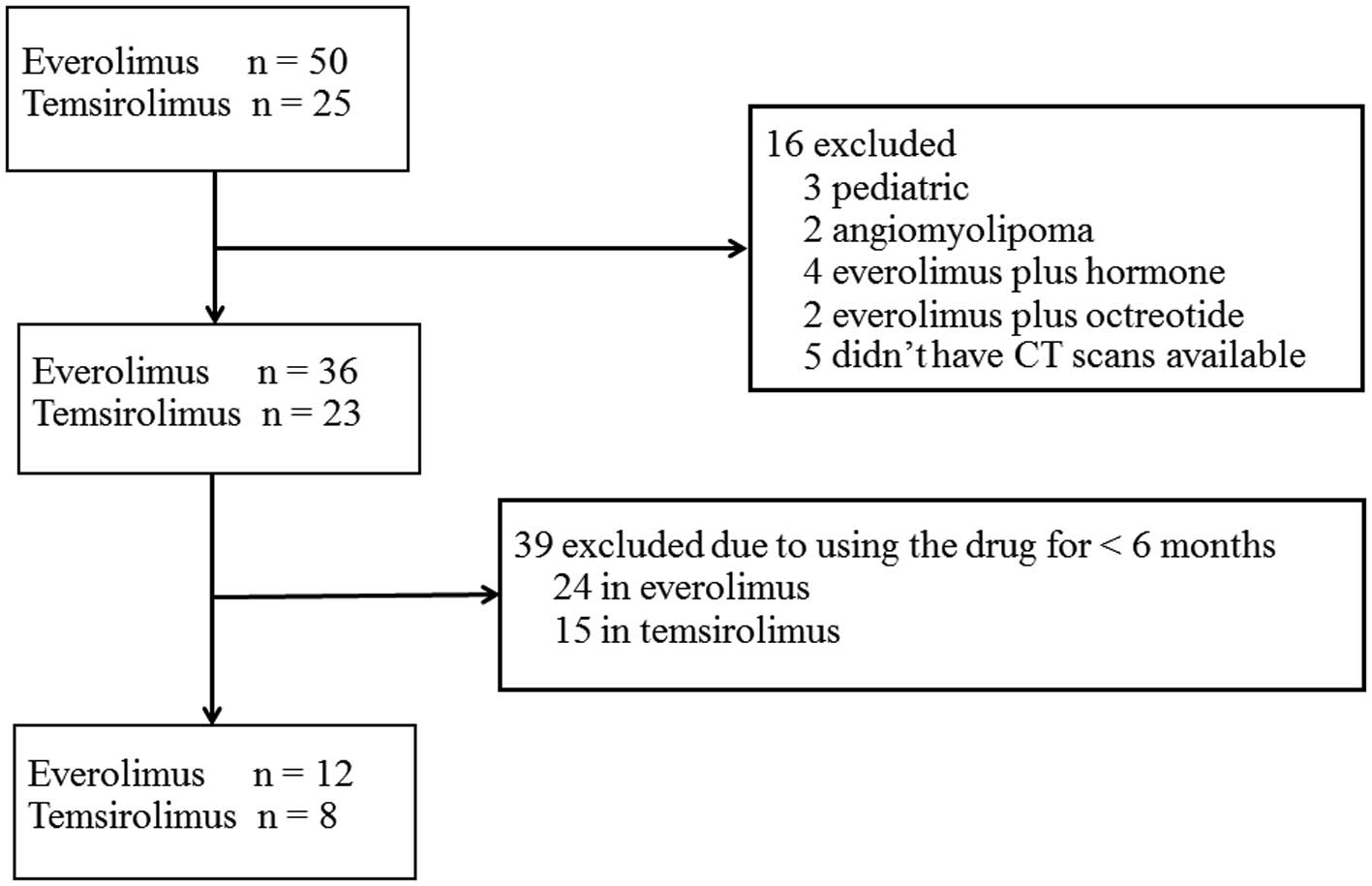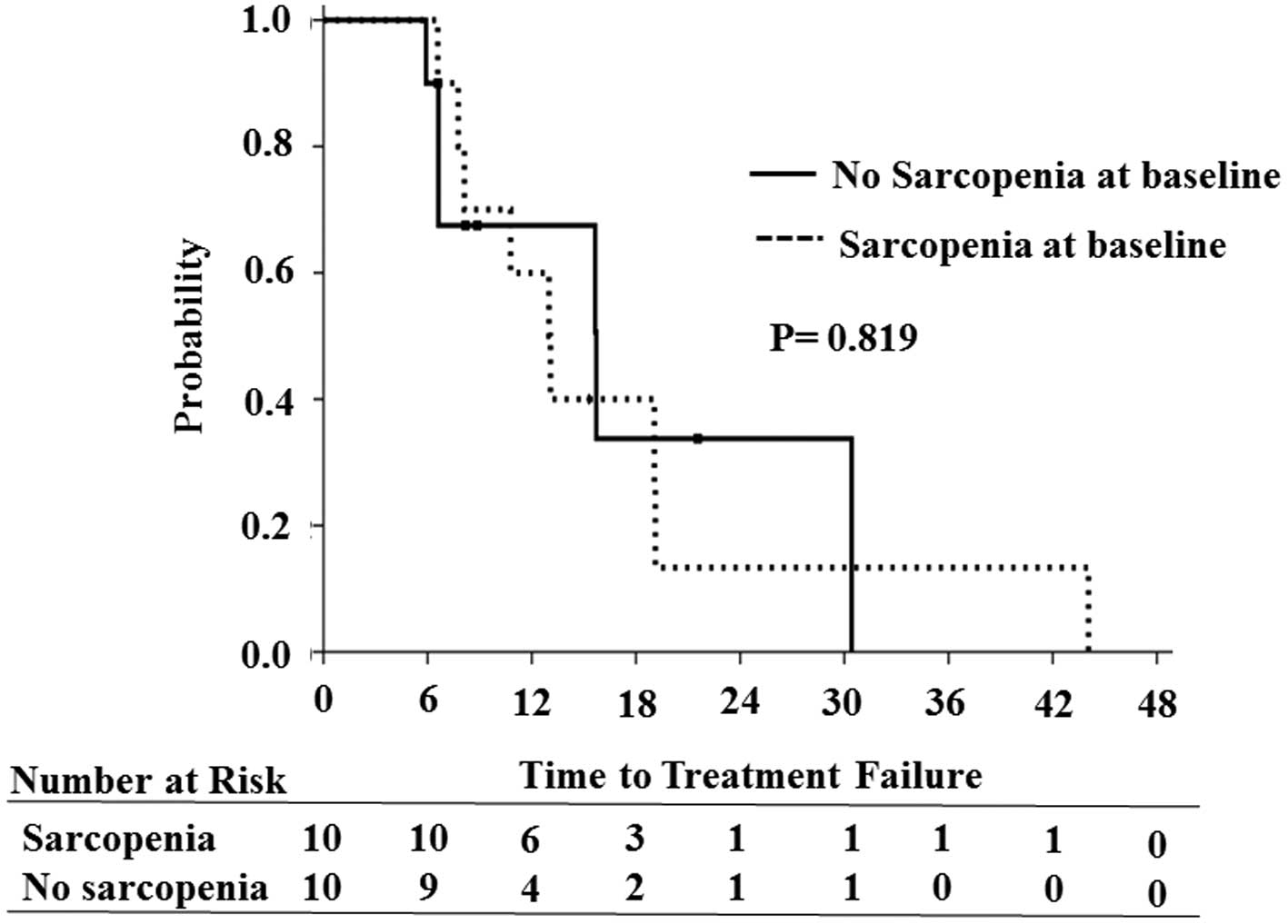|
1
|
Baumgartner RN, Koehler KM, Gallagher D,
Romero L, Heymsfield SB, Ross RR, Garry PJ and Lindeman RD:
Epidemiology of sarcopenia among the elderly in New Mexico. Am J
Epidemiol. 147:755–763. 1998. View Article : Google Scholar : PubMed/NCBI
|
|
2
|
Prado CM, Baracos VE, McCargar LJ, Reiman
T, Mourtzakis M, Tonkin K, Mackey JR, Koski S, Pituskin E and
Sawyer MB: Sarcopenia as a determinant of chemotherapy toxicity and
time to tumor progression in metastatic breast cancer patients
receiving capecitabine treatment. Clin Cancer Res. 15:2920–2926.
2009. View Article : Google Scholar : PubMed/NCBI
|
|
3
|
van Vledder MG, Levolger S, Ayez N,
Verhoef C, Tran TC and Ijzermans JN: Body composition and outcome
in patients undergoing resection of colorectal liver metastases. Br
J Surg. 99:550–557. 2012. View
Article : Google Scholar : PubMed/NCBI
|
|
4
|
Tan BH, Birdsell LA, Martin L, Baracos VE
and Fearon KC: Sarcopenia in an overweight or obese patient is an
adverse prognostic factor in pancreatic cancer. Clin Cancer Res.
15:6973–6979. 2009. View Article : Google Scholar : PubMed/NCBI
|
|
5
|
Grossberg AJ, Chamchod S, Fuller CD,
Mohamed AS, Heukelom J, Eichelberger H, Kantor ME, Hutcheson KA,
Gunn GB, Garden AS, et al: Association of body composition with
survival and locoregional control of radiotherapy-treated head and
neck squamous cell carcinoma. JAMA Oncol. 2:782–789. 2016.
View Article : Google Scholar : PubMed/NCBI
|
|
6
|
Antoun S, Baracos VE, Birdsell L, Escudier
B and Sawyer MB: Low body mass index and sarcopenia associated with
dose-limiting toxicity of sorafenib in patients with renal cell
carcinoma. Ann Oncol. 21:1594–1598. 2010. View Article : Google Scholar : PubMed/NCBI
|
|
7
|
Mir O, Coriat R, Blanchet B, Durand JP,
Boudou-Rouquette P, Michels J, Ropert S, Vidal M, Pol S, Chaussade
S and Goldwasser F: Sarcopenia predicts early dose-limiting
toxicities and pharmacokinetics of sorafenib in patients with
hepatocellular carcinoma. PLoS One. 7:e375632012. View Article : Google Scholar : PubMed/NCBI
|
|
8
|
Huillard O, Mir O, Peyromaure M, Tlemsani
C, Giroux J, Boudou-Rouquette P, Ropert S, Delongchamps NB, Zerbib
M and Goldwasser F: Sarcopenia and body mass index predict
sunitinib-induced early dose-limiting toxicities in renal cancer
patients. Br J Cancer. 108:1034–1041. 2013. View Article : Google Scholar : PubMed/NCBI
|
|
9
|
Massicotte MH, Borget I, Broutin S,
Baracos VE, Leboulleux S, Baudin E, Paci A, Deroussent A,
Schlumberger M and Antoun S: Body composition variation and impact
of low skeletal muscle mass in patients with advanced medullary
thyroid carcinoma treated with vandetanib: results from a
placebo-controlled study. J Clin Endocrinol Metab. 98:2401–2408.
2013. View Article : Google Scholar : PubMed/NCBI
|
|
10
|
Fearon K, Strasser F, Anker SD, Bosaeus I,
Bruera E, Fainsinger RL, Jatoi A, Loprinzi C, MacDonald N,
Mantovani G, et al: Definition and classification of cancer
cachexia: An international consensus. Lancet Oncol. 12:489–495.
2011. View Article : Google Scholar : PubMed/NCBI
|
|
11
|
Bodine SC, Stitt TN, Gonzalez M, Kline WO,
Stover GL, Bauerlein R, Zlotchenko E, Scrimgeour A, Lawrence JC,
Glass DJ and Yancopoulos GD: Akt/mTOR pathway is a crucial
regulator of skeletal muscle hypertrophy and can prevent muscle
atrophy in vivo. Nat Cell Biol. 3:1014–1019. 2001. View Article : Google Scholar : PubMed/NCBI
|
|
12
|
Edinger AL and Thompson CB: Akt maintains
cell size and survival by increasing mTOR-dependent nutrient
uptake. Mol Biol Cell. 13:2276–2288. 2002. View Article : Google Scholar : PubMed/NCBI
|
|
13
|
Antoun S, Birdsell L, Sawyer MB, Venner P,
Escudier B and Baracos VE: Association of skeletal muscle wasting
with treatment with sorafenib in patients with advanced renal cell
carcinoma: Results from a placebo-controlled study. J Clin Oncol.
28:1054–1060. 2010. View Article : Google Scholar : PubMed/NCBI
|
|
14
|
Prado CM, Bekaii-Saab T, Doyle LA,
Shrestha S, Ghosh S, Baracos VE and Sawyer MB: Skeletal muscle
anabolism is a side effect of therapy with the MEK inhibitor:
Selumetinib in patients with cholangiocarcinoma. Br J Cancer.
106:1583–1586. 2012. View Article : Google Scholar : PubMed/NCBI
|
|
15
|
Prado CM, Lieffers JR, McCargar LJ, Reiman
T, Sawyer MB, Martin L and Baracos VE: Prevalence and clinical
implications of sarcopenic obesity in patients with solid tumours
of the respiratory and gastrointestinal tracts: A population-based
study. Lancet Oncol. 9:629–635. 2008. View Article : Google Scholar : PubMed/NCBI
|
|
16
|
Mourtzakis M, Prado CM, Lieffers JR,
Reiman T, McCargar LJ and Baracos VE: A practical and precise
approach to quantification of body composition in cancer patients
using computed tomography images acquired during routine care. Appl
Physiol Nutr Metab. 33:997–1006. 2008. View
Article : Google Scholar : PubMed/NCBI
|
|
17
|
Shen W, Punyanitya M, Wang Z, Gallagher D,
St-Onge MP, Albu J, Heymsfield SB and Heshka S: Total body skeletal
muscle and adipose tissue volumes: Estimation from a single
abdominal cross-sectional image. J Appl Physiol (1985).
97:2333–2338. 2004. View Article : Google Scholar : PubMed/NCBI
|
|
18
|
Fearon K, Arends J and Baracos V:
Understanding the mechanisms and treatment options in cancer
cachexia. Nat Rev Clin Oncol. 10:90–99. 2013. View Article : Google Scholar : PubMed/NCBI
|
|
19
|
Veasey-Rodrigues H, Parsons HA, Janku F,
Naing A, Wheler JJ, Tsimberidou AM and Kurzrock R: A pilot study of
temsirolimus and body composition. J Cachexia Sarcopenia Muscle.
4:259–265. 2013. View Article : Google Scholar : PubMed/NCBI
|
|
20
|
Adegoke OA, Abdullahi A and Tavajohi-Fini
P: mTORC1 and the regulation of skeletal muscle anabolism and mass.
Appl Physiol Nutr Metab. 37:395–406. 2012. View Article : Google Scholar : PubMed/NCBI
|
|
21
|
Martin L, Birdsell L, Macdonald N, Reiman
T, Clandinin MT, McCargar LJ, Murphy R, Ghosh S, Sawyer MB and
Baracos VE: Cancer cachexia in the age of obesity: Skeletal muscle
depletion is a powerful prognostic factor, independent of body mass
index. J Clin Oncol. 31:1539–1547. 2013. View Article : Google Scholar : PubMed/NCBI
|
















